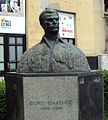Đuro Đaković
Đuro Đaković | |
|---|---|
 Đuro Đaković | |
| Born | 30 November 1886 |
| Died | 29 April 1929 (aged 42) |
Đuro Đaković (30 November 1886 – 25 April 1929) was a Yugoslav metal worker, communist and revolutionary. Đaković was the organizational secretary of the Central Committee of the Communist Party of Yugoslavia, from April 1928 to April 1929 and one of the most prominent fighters of the working class of Yugoslavia.[1]
Life

Born in the village of Brodski Varoš near Slavonski Brod, in Austria-Hungary's Kingdom of Croatia-Slavonia, to family of Croat peasants, he moved to Sarajevo in search of a job as a trained metal worker at the age of 18, where, in November 1905, he joined the newly-formed Radical Movement Union, and took part in several strikes in the following years. His son Stjepan, who was born in Sarajevo in 1912, also become a communist, and at the outbreak of WWII he joined partisans. In 1942 Stjepan was killed by the Ustaše.[1]
At a gathering in the suburbs of Sarajevo, in early 1915, he raised his voice against the war, for which he was arrested and brought before a military court, which condemned him to death. He was later transferred to the jurisdiction of the civil court, who pardoned him and sentenced him to forced labor.[1]
After the war, Đuro Đaković's revolutionary activity began. At the end of February, he organised a general strike of the disadvantaged workers' class attended by 30,000 workers. He was committed to making the right to vote for women and all people who have reached the age of 20 and who lived in Sarajevo for more than six months.[1]
Đaković took part in the Unification Congress in which the Communist Party of Yugoslavia was created, and due to participation in the preparation and holding of the May 1st celebration in Sarajevo, he was arrested and spent several months in custody. At the beginning of the 1920s, he began with active political work. He was elected to the parliamentary elections for the People's Assembly of the Constitutional Assembly of the Kingdom of the Serbs, Croats and Slovenes. In June 1921 he travelled to Moscow as a delegate at the Third Congress of Comintern, and after returning to Yugoslavia he was again arrested and sentenced to ten months in prison for communist and unionist activities.[1]
Đaković continued with the revolutionary work, and after several more arrests in 1923, he was expelled from Sarajevo to his homeland. In 1927, he enrolled at Moscow's International Lenin School and stayed there until 1928. Under the pseudonym of Bosnić he returned to Yugoslavia and worked on setting up party organizations.[1]
Đaković actively opposed the January 6 Dictatorship of King Alexander I. Due to this, he was arrested in Zagreb together with Nikola Hećimović, secretary of the International Red Aid. They were executed on the Yugoslav-Austrian border on April 25, 1929. In an exaggerated attempt to escape responsibility, authorities have tried to conceal the murder. After exhumation, it was found that the victims were fired at a small distance, which proved to be a murder.[1]
Memory

In summer 1937, Đaković's name was given to one of the battalions of the 129th International Brigade of the Spanish Republican Army.[2]
In 1942, in Belgium a military resistance movement unit made up of Yugoslav immigrants, mostly miners, originating from the Dalmatian border and the surrounding area of Imotski, also took his name.[1] [3]
In his birthplace Slavonski Brod, the wagon factory where Đaković once worked was named after him in 1947.[1] The company is still known as Đuro Đaković Grupa d.d..
In Sarajevo, Alipaša Street was named after him from 1945 to the 1990s. His name was also given to the Bosnian Cultural Center, the main cinema hall in post-war Sarajevo. A memorial park with a statue was built nearby Alipaša Street in 1973, on a project by Ljubomir Denković, professor at the Academy of Art in Novi Sad, in a style that art historian and museum advisor Miloš Arsić called sculptures of natural vitalism. The memorial park was renamed in 2017 in honour of the 1st Corps of the RBiH Army.[1]
From 1945 to 1990 a street in Zagreb was named after him, Đuro Đaković Workers' Street (Radnička cesta Đure Đakovića). The name was shortened to Workers' Street (Radnička cesta) after the Croatian War of Independence.
A street in Ljubljana was also renamed after him, Đaković Road (Template:Lang-sl), but the original name Litostroj Road (Litostrojska cesta) was restored in 1993.[4]
In Belgrade, the street once named after him was later re-dedicated to Georges Clemenceau.
-
Memorial plaque dedicated to Đuro Đaković in George Clemenceau Street (former Đuro Đaković Street), Belgrade.
-
Bust of Đuro Đaković at the Tomb of People's Heroes in Belgrade Fortress
-
Bust of Đuro Đaković in Belgrade
-
Bust of Đuro Đaković in Zagreb
-
Statue of Đuro Đaković in his birthplace near Slavonski Brod
References
- ^ a b c d e f g h i j "Spomenik koji krasi centar Sarajeva: Ko je bio Đuro Đaković". Radio Sarajevo. 25 May 2018. Retrieved 9 December 2018.
- ^ Hervé Lemesle, « Des médailles et leurs revers. Des anciens d’Espagne devenus « héros des peuples de Yougoslavie » », Cahiers balkaniques, 38-39 | 2011, 37-70, https://journals.openedition.org/ceb/761
- ^ "According to Većeslav Holjevac around 6,000 Croats lived in Belgium prior to World War II. Holjevac claims that around 2,000 immigrants in Belgium from the former Yugoslavia participated in the Belgium underground, around 150 of whom served in two armed resistance units, the Đuro Đaković and Blagoje Parović, named after, respectively, a Croat and a Serb Communist leader." Kraljić, John (15 June 2007). "Ethnic Croatians Killed by Nazi and Fascist Forces: Introduction". www.croatia.org. Retrieved 9 December 2018.
- ^ (in Slovene) http://www.uradni-list.si/1/content?id=65400
External links
 Media related to Đuro Đaković at Wikimedia Commons
Media related to Đuro Đaković at Wikimedia Commons






